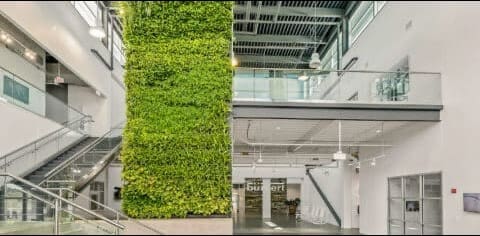Without a doubt, living walls look stunning and provide large swathes of real planting from floor to ceiling, creating a real impact…
A living wall can have numerous benefits in business environments; they can help to make staff more productive in the workplace and are equally important in improving the perception of your brand. In this article, you can find out the main points to consider when thinking about a living wall for your space, and why it could be important for your staff or guests.
Can I have a living wall?
Almost definitely yes! Or at least, the effect that a living wall can give. We create bespoke walls for your requirements, though there will be some spaces more suited to live living walls than others.
A living wall works best in a well-lit space with plenty of room and fresh air circulating. For example, entrance atriums and large reception areas with hard or concrete floors. It is ideal to install them when a building is being constructed so that the irrigation system can be put in and the living wall placed on top. This can also off-set some of the cost, as the wall won’t need plastering and painting.
If you have a carpeted area or a space with lower light levels, such as a restaurant or traditional carpeted office reception, you could consider an artificial living wall instead. These look beautiful and give a very similar effect, creating the same kind of wow factor. For office spaces, moss walls also make an excellent option for giving a high impact finish, they are easy to retrofit and require minimal ongoing maintenance.
Another option to include real, live planting without the commitment and expense of a full living wall, is to opt for live dividers or panels. These are self-contained green modular products and give a great effect. These can be replanted on a regular basis to give a different look and so can be treated like art installations. You can also use them to give seasonal variation to your location…
Where is the best location for different types of green walls?
The best type of wall for you will depend on your location and the requirements of the plants you select. For example, some plants need more light than others so if you are planning to place your living wall in a bright and airy reception, you will have lots of options for the type of plants you can use. For dark areas, you may need a growing light. You can also opt for moss walls or artificial living walls as these are perfect options for many spaces. Moss walls look exquisite when executed by professional plant technicians like Planteria. With lots of colour options and three different types of moss to choose from; bun moss, flat moss or reindeer moss, there are lots of variations to make your wall unique. You can also include your logo or a message and have something bespoke and specific to your company.
Here’s some more reading material on living walls to get you inspired for your new project:
It’s Alive! Buildings with Living Walls
What is A living picture and what types of living walls are there?
A living picture is a self-contained piece of art with a frame and a central section of planting. Living pictures look beautiful and can be hung singularly or in groups. Also available in this type of product are living panels and dividers. These are easy to maintain and a cheaper option than a full-scale living wall. There are lots of options for different types of planting and it can be regularly changed to give different effects throughout the year. If you move offices, you can even take these with you which you can’t do with a traditional built-in living wall.
When would I opt for Moss wall?
We supply sixteen different colours of preserved moss which can be used to beautifully create bespoke walls and even replicate your logo. Most moss is not recommended for use in exterior positions, but for interiors it is easy to manage and control. It is lightweight and fairly straightforward to install, making it ideal for most office environment.
Why would I choose an artificial living wall?
An artificial living wall brings many of the design benefits of a real living wall, with far less maintenance or ongoing costs associated with a real living wall. Obviously, an artificial plant does not grow, and you won’t reap the benefits of the air cleansing and CO2 absorption that you get with real planting. You also need to consider that artificial planting, made from plastics, is not as environmentally friendly as the real deal. However, just like interior furnishings, they last a long time and can be moved with you if you are moving offices, so this should be weighed up in your considerations.
Which are best and why?
There is no right answer to this question as whether you opt for a traditional built in living wall with its own Irrigation system, an artificial living wall, a living picture, panel, divider, or moss wall, will largely depend on your vision for your premises and the constraints of your environment and budget.
When planning in your green wall, you need to ask your plant provider questions like:
- Is this right for my space?
- How much will it cost to install?
- What will the monthly cost of ongoing maintenance be?
- What possible issues might occur that I need to keep in mind for the future?
If you would like to discuss your location and options to help you decide which is best for you, please get in touch with Planteria group today for a free consultation and quotation service.










